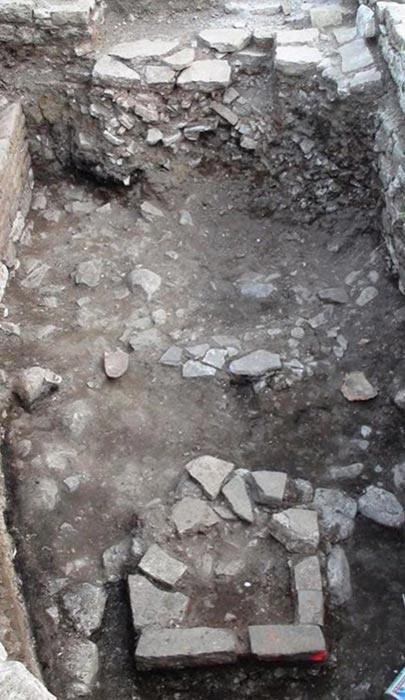Two Ancient Palaces Unearthed in Montenegro Were Home to Famous Illyrian Rulers
A team of archeologists from the University of Warsaw in Poland has unearthed the first known palace of the Illyrian kings in Montenegro. The discovery is impressive and expands the knowledge about the functioning of the royal power in Illyria.
According to PAP Science, the palace was found during excavations at the ancient settlement of Rhizon, located in present day Risan in Montenegro, which was once capital of the famous Queen Teuta the Untameable, whose actions caused the First Illyrian War in 229 BC. Teuta was the wife of Agron, a king of the Ardiaean kingdom. Until now the work at the site, which has been ongoing since 2000, has allowed historians to revise the order of the reign of the Illyrian kings. Researchers have now concluded that King Ballaios was not a successor of Queen Teuta, as previously believed, but was her predecessor.

Illyrian Queen Teuta and The National Bank of Albania, Durres. (realmonte.net)
The team of researchers from the Antiquity of Southeastern Europe Research Center of the University of Warsaw have focused their recent excavations on the representative section of the city. In this elevated area of the site, archeologists unearthed the foundations of the impressive buildings dated back to the 3th century BC. The Hellenistic palace complex was built before 260 BC, the second after 250 BC. The structures are the first of this type uncovered in the region called Illyria. The palaces are believed to have been home to the famous Illyrian Rulers King Ballaios and Queen Teuta. The area of the excavation site was unexplored until now, so researchers had no idea about the treasure that lay hidden beneath the ground.

Corner of the younger palace. Photo by P. Dyczek
There are only a few places that belonged to the Illyrian rulers that have survived the passage of time. However, the ruins discovered in Rhizon are an unexpected and impressive example of Illyrian architecture.
"The location of buildings, their scale, plan, and used building techniques are completely unusual and unique, when compared with the previously known examples of Illyrian architecture, including the structures already discovered in Risan. It appears that we have unveiled a place known from sources from the antiquity. It is a rare case in archeology. Usually we are not able to identify the specific location of important events, such as the exact place of Caesar's death" - explained Prof. Dyczek.

The beautiful city of Risan, Montenegro (public domain)
According to the researchers, the older part of the palace was a large room in the form of a megaron with a fireplace located at the center. An offering consisting of 30 coins was discovered in the foundation of the hearth. Apart from this, on both sides were marble columns, and the room contained fragments of luxury Hellenistic table vessels. In the area around the megaron was a storage room for amphorae. The palace was burned down during the violent attack, but the ruins became the basis for the second palace. The megaron was replaced with the kitchen or a banquet hall.

Hearth within the megaron. Photo by P. Dyczek
The second palace was also damaged and looted in ancient times, however, due to the excavations it is known that bossages decorated the face of the wall. The floor was made from flat slabs or limestone, but perhaps replaced later with fine pebbles, which were formed in a mosaic. The researchers also found fragments of two large door knockers. The interior of the palace was divided into at least three areas. Moreover, one of the entrances was decorated with half-columns molded in mortar. The remains of the palace were used to build a sawmill in Rhizon.
The Illyrians were a very interesting culture, in which women held a strong position. As April Holloway from Ancient Origins reported on September 2, 2014:
''Five 1800-year-old ivory tablets found in the Albanian city of Durres have just been deciphered shedding new light on the role that women played in ancient Illyrian culture... Inscriptions on the wax tablets suggest that women engaged in high level financial transactions, adding weight to the view that women held equal status to men in ancient Illyria.
The wax tablets were first discovered in 1979 by Albanian archaeologist Fatos Tartari, who came across the unique finding of a large glass urn filled with a black liquid inside an ancient monumental tomb. Inside the liquid were two styluses, an ebony comb, and five ivory tablets used for writing, which were coated in wax. The hair comb, as well as other features of the tomb, indicate that it belonged to a wealthy and aristocratic woman. The inscriptions have now been deciphered by Albanian and German scholars, who have revealed that the writing reveals new insights about life in the former Roman colony of Dyrrachium (now modern-day Durres) in the 2nd century AD. Dyrrachium had been inhabited since the 7 th century BC, but came under Roman rule following the Illyrian Wars with the Roman Republic in 169 BC.''
Top image: General view of the research area where the Illyrian palace was found. Photo by P. Dyczek


















